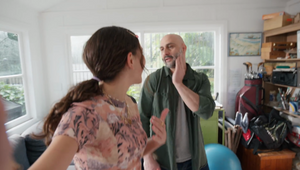
The Case for Stop-Motion Animation in Advertising

As a stop motion director and animator I spend days on end in a studio, blinds drawn, shut in from the rest of the world as I bring inanimate objects to life. You could say I’m the perfect type of creative for working in isolation. There are no human cast members to manage, my locations are all indoors and crews can be kept to a minimum.
Stop motion is an animation technique where a filmmaker physically moves an object, taking photographs of each new position. When these photos are played back in sequence it creates the illusion of movement.
Stop-motion animation has a unique aesthetic that is inherently timeless. It has a hand-made feel with organic imperfections which is part of its appeal. The craft that goes into stop motion, from the models and sets to the actual animation, make it a technique that stands out from all other forms of animation. The beauty of stop-motion is the fact that you can animate a vast array of materials and objects. Clay, plasticine, paper, people, found objects, food, purpose built puppets and pretty much any inanimate object. This makes it perfect for advertising physical products as you can bring them to life, control how they’re lit and photographed and you’re showing the actual product in a functional yet creative way.
On a stop-motion production you have a lot of control over the movement and expression of the animation. Everything is planned out in pre-production so everyone knows exactly what is being shot on the day.
The idea generation process for a stop-motion script can be a very imaginative process. Once you understand the technique you can start thinking about how products and objects can be animated.
The process always starts with a script and storyboards. Once the script is approved we produce an animatic which is like a simple animated storyboard. This is used to figure out the timing of all the shots and how the narrative unfolds. This is great to show to the client before any of the actual stop motion animation begins. During this phase we can identify any problems in the narrative or technical issues for each shot. I also like to produce test animations to figure out how certain things will work, what they might look like on screen and also to figure out how a shot will physically work on set.
Pre-production also includes any prop builds, set builds and rigging involved to support the props or puppets. Depending on the type of production we may work with model makers, prop builders, paper engineers, food stylists, puppet fabricators, motion control and rigging experts and visual effects consultants.
Once the team is assembled and all the sets and props are built it’s time to shoot. Most TVCs are shot in 1-2 very long days, but because everything has been meticulously planned in pre-production we know exactly what’s required to get it all done. We usually divide the workload into separate units so that we have multiple animators working simultaneously on different shots and sequences. As the director I like to bounce between the units while also animating on a set myself.
The post production phase for a stop-motion animation is different to a live action project as we don’t shoot multiple takes and therefore the edit is pretty much the same as the animatic. Moving forward the animation might require rig removal or compositing different stop-motion elements together to create the one shot. Or CGI elements could be added in if the project requires.
I love to collaborate with creatives in the initial stages of script and concept development so that we can work together on what’s possible. That might be having an initial creative meeting, researching and sharing reference videos or creating test shots. I want to bring creative solutions to the table, bounce ideas and refine concepts using a combination of stop motion, CGI and live action to create visuals that cut through the noise and make audiences take notice.















